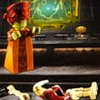Friends Controversy
525 members have voted
-
1. Do you like the LEGO Friends line?
-
Yes382
-
No140
-
-
2. Do you think the LEGO Friends line is too "effeminite" in appearance?
-
Yes195
-
No327
-
-
3. How could LEGO improve this "problem?"
-
I answered "No." I don't see any need for improvement.221
-
Make building more challenging68
-
Make monster trucks with female drivers35
-
Make monster trucks in pink26
-
Make houses in neutral colors108
-
Just let girls play with the other lines. Can't girls like construction without animals, lipstick and brighter colors?83
-
The sets are fine, but why are the minifigs different?190
-
Diversify other lines in theme78
-
Diversify other lines with more female characters163
-
Diversify other lines with brighter colors that appeal to boys and girls75
-
-
4. Which of the above issues affects your stance on this product the most?
-
I answered "No." I don't see any need for improvement.211
-
Make building more challenging23
-
Make monster trucks with female drivers3
-
Make monster trucks in pink6
-
Make houses in neutral colors28
-
Just let girls play with the other lines. Can't girls like construction without animals, lipstick and brighter colors?39
-
The sets are fine, but why are the minifigs different?126
-
Diversify other lines in theme21
-
Diversify other lines with more female characters53
-
Diversify other lines with brighter colors that appeal to boys and girls13
-
-
5. What is your expertise on the subject?
-
I have studied sociology62
-
I have studied child development54
-
I am just an opinionated AFOL with no credentials in marketing or child development335
-
I have studied consumer product research38
-
I have studied marketing55
-
I am a parent150
-
-
6. How do your children respond to the LEGO Friends line?
-
I do not have children344
-
I have a daughter who likes the Friends sets63
-
I have a daughter who doesn't like the Friends sets13
-
I have a daughter who likes the Friends sets and sets meant for boys60
-
I have a son who likes the Friends sets28
-
I have a son who doesn't like the Friends sets25
-
I have many children who all have different reactions to the Friends line24
-
-
7. Do you consider LEGO to be a unisex toy?
-
Yes349
-
No40
-
It used to be, it's not now52
-
It has always been a toy primarily for boys67
-
-
8. Do you think keeping Friends promoted only among girls toys in store and not with LEGO will reinforce the impression that LEGO is a boys toy in general?
-
Yes313
-
No195
-
-
9. Do sets marketed specifically to girls enforce the idea that the other sets are meant only for boys?
-
Yes285
-
No223
-
-
Recently Browsing 0 members
No registered users viewing this page.

